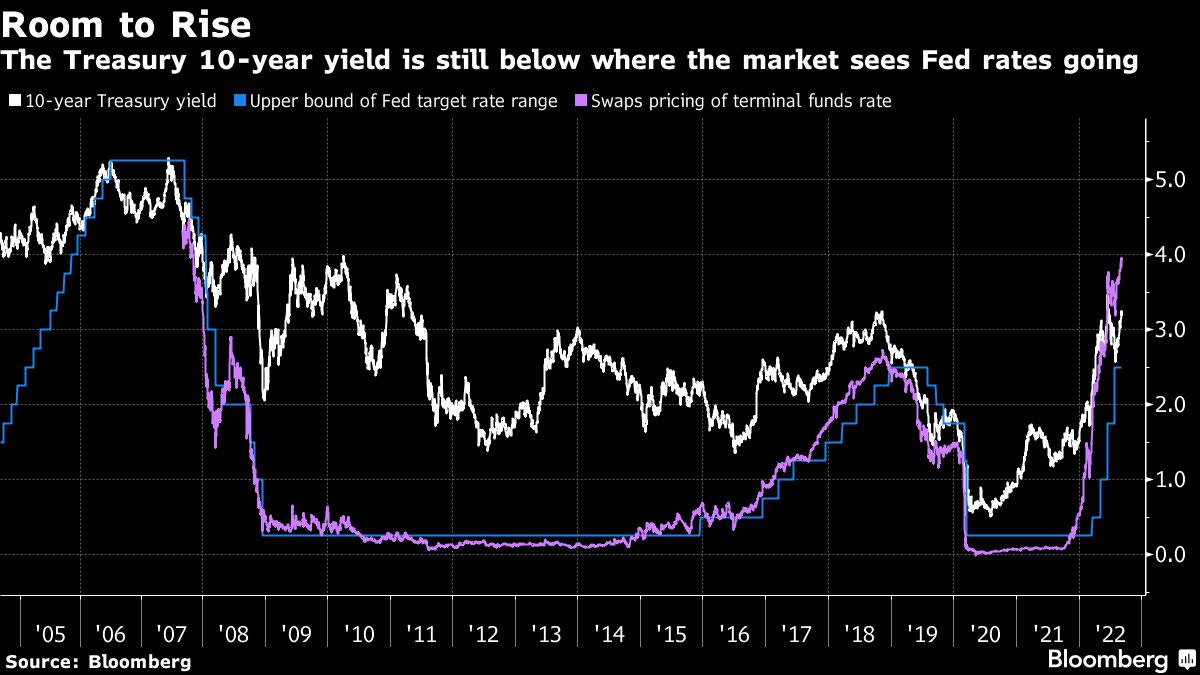
(Bloomberg) — Investors who might be looking for the world’s biggest bond market to rally back soon from its worst losses in decades appear doomed to disappointment.
The US employment report on Friday illustrated the momentum of the economy in face of the Federal Reserve’s escalating effort to cool it down, with businesses rapidly adding jobs, pay rising and more Americans entering the workforce. While Treasury yields slipped as the figures showed a slight easing of wage pressures and an uptick in the jobless rate, the overall picture reinforced speculation the Fed is poised to keep raising interest rates — and hold them there — until the inflation surge recedes.
Swaps traders are pricing in a slightly better-than-even chance that the central bank will continue lifting its benchmark rate by three-quarters of a percentage point on Sept. 21 and tighten policy until it hits about 3.8%. That suggests more downside potential for bond prices because the 10-year Treasury yield has topped out at or above the Fed’s peak rate during previous monetary-policy tightening cycles. That yield is at about 3.19% now.
Inflation and Fed hawkishness have “bitten the markets,” said Kerrie Debbs, a certified financial planner at Main Street Financial Solutions. “And inflation is not going away in a couple of months. This reality bites.”
The Treasury market has lost over 10% in 2022, putting it on pace for its deepest annual loss and first back-to-back yearly declines since at least the early 1970s, according to a Bloomberg index. A rebound that started in mid-June, fueled by speculation a recession would result in rate cuts next year, has largely been erased as Fed Chair Jerome Powell emphasized that he is focused squarely on pulling down inflation. Two-year Treasury yields on Thursday hit 3.55%, the highest since 2007.
At the same time, short-term real yields — or those adjusted for expected inflation — have risen, signaling a significant tightening of financial conditions.
Rick Rieder, the chief investment officer of global fixed income at BlackRock Inc., the world’s biggest asset manager, is among those who think long-term yields may rise further. He said in an interview on Bloomberg TV Friday that he expects a 75-basis-point hike in the Fed’s policy rate this month, which would be the third straight move of that size.
The Friday labor report showing a slowdown in payroll growth allowed markets a “sigh of relief,” according to Rieder. He said his firm has been buying some short-term fixed-income securities to seize on the large run up in yields, but he thinks those on longer-maturity bonds have further room to increase.
“I can see rates move higher in the long end,” he said. “I think we are in a range. I think we are in the upper end of the range. But I think it’s pretty hard to say we’ve seen the highs currently.”
The employment report was the last major look at the job market before this month’s meeting of the Federal Open Market Committee.
The upcoming holiday-shortened week has some economic reports set to be released, including surveys of purchasing managers, the Fed’s Beige Book glimpse of regional conditions, and weekly figures on unemployment benefits. US markets will be close Monday for the Labor Day holiday, and the most significant indicator before the Fed meeting will be the consumer-price index release on Sept. 13.
But the market will parse closely comments from an array of Fed officials set to speak publicly over the coming week, including Cleveland Fed President Loretta Mester. She said Wednesday that policy makers should push the fed funds rate to over 4% by early next year and indicated that she doesn’t expect rate cuts in 2023.
Greg Wilensky, head of US fixed income at Janus Henderson, said he’s also focused on the upcoming release of wage data from the Atlanta Fed before the next policy-setting meeting. On Friday, the Labor Department reported that average hourly earnings rose 5.2% in August from a year earlier. That was slightly less than the 5.3% expected by economists, but it still shows upward pressure on wages from the tight labor market.
“I’m in the 4% to 4.25% camp on the terminal rate,” Wilensky said. “People are realizing that the Fed won’t pause on softer economic data unless inflation weakens dramatically.”
The specter of an aggressive Fed tightening has also hammered stocks, leaving the S&P 500 Index down more than 17% this year. While US shares rallied off June lows until mid-August, they have since given back much of those gains as wagers on an imminent recession and 2023 rate cuts were unwound.
“You need to remain humble about your ability to forecast data and how rates will react,” said Wilensky, whose core bond funds remain underweight Treasuries. “The worst is over as the market is doing a more reasonable job of pricing in where rates should be. But the big question is what is going on with inflation?”
©2022 Bloomberg L.P.